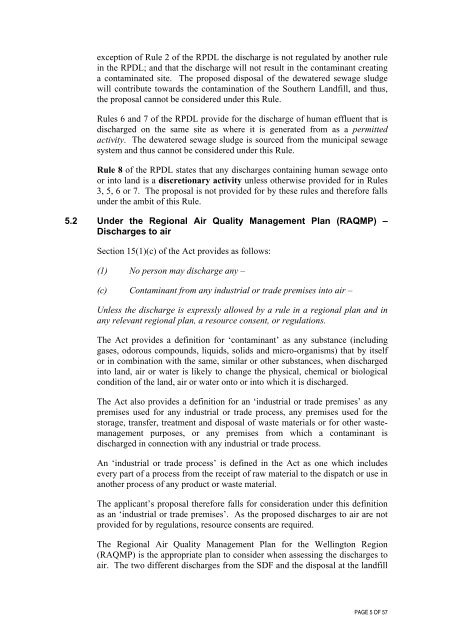Decision report- Carey's Gully Sludge Dewatering Facility - Greater ...
Decision report- Carey's Gully Sludge Dewatering Facility - Greater ...
Decision report- Carey's Gully Sludge Dewatering Facility - Greater ...
You also want an ePaper? Increase the reach of your titles
YUMPU automatically turns print PDFs into web optimized ePapers that Google loves.
exception of Rule 2 of the RPDL the discharge is not regulated by another rule<br />
in the RPDL; and that the discharge will not result in the contaminant creating<br />
a contaminated site. The proposed disposal of the dewatered sewage sludge<br />
will contribute towards the contamination of the Southern Landfill, and thus,<br />
the proposal cannot be considered under this Rule.<br />
Rules 6 and 7 of the RPDL provide for the discharge of human effluent that is<br />
discharged on the same site as where it is generated from as a permitted<br />
activity. The dewatered sewage sludge is sourced from the municipal sewage<br />
system and thus cannot be considered under this Rule.<br />
Rule 8 of the RPDL states that any discharges containing human sewage onto<br />
or into land is a discretionary activity unless otherwise provided for in Rules<br />
3, 5, 6 or 7. The proposal is not provided for by these rules and therefore falls<br />
under the ambit of this Rule.<br />
5.2 Under the Regional Air Quality Management Plan (RAQMP) –<br />
Discharges to air<br />
Section 15(1)(c) of the Act provides as follows:<br />
(1) No person may discharge any –<br />
(c) Contaminant from any industrial or trade premises into air –<br />
Unless the discharge is expressly allowed by a rule in a regional plan and in<br />
any relevant regional plan, a resource consent, or regulations.<br />
The Act provides a definition for ‘contaminant’ as any substance (including<br />
gases, odorous compounds, liquids, solids and micro-organisms) that by itself<br />
or in combination with the same, similar or other substances, when discharged<br />
into land, air or water is likely to change the physical, chemical or biological<br />
condition of the land, air or water onto or into which it is discharged.<br />
The Act also provides a definition for an ‘industrial or trade premises’ as any<br />
premises used for any industrial or trade process, any premises used for the<br />
storage, transfer, treatment and disposal of waste materials or for other wastemanagement<br />
purposes, or any premises from which a contaminant is<br />
discharged in connection with any industrial or trade process.<br />
An ‘industrial or trade process’ is defined in the Act as one which includes<br />
every part of a process from the receipt of raw material to the dispatch or use in<br />
another process of any product or waste material.<br />
The applicant’s proposal therefore falls for consideration under this definition<br />
as an ‘industrial or trade premises’. As the proposed discharges to air are not<br />
provided for by regulations, resource consents are required.<br />
The Regional Air Quality Management Plan for the Wellington Region<br />
(RAQMP) is the appropriate plan to consider when assessing the discharges to<br />
air. The two different discharges from the SDF and the disposal at the landfill<br />
PAGE 5 OF 57
















